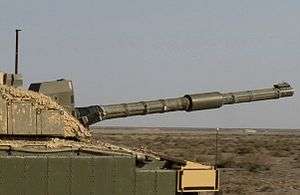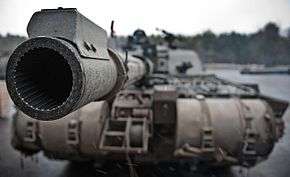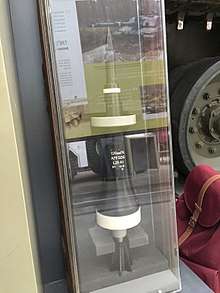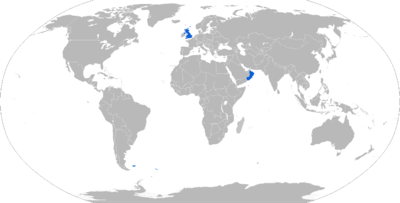Royal Ordnance L30
The L30A1, officially designated Gun 120 mm Tk L30,[lower-roman 1] is a 120 mm rifled tank gun used by the British Army and Royal Army of Oman. It is fitted in the turret of the Challenger 2 main battle tank. It is an improved production model of the Royal Ordnance L11 series of rifled tank guns.
| L30A1 | |
|---|---|
 Gun of a Challenger 2 tank of the Royal Scots Dragoon Guards, Basra, Iraq, November 2008 | |
| Place of origin | United Kingdom |
| Service history | |
| In service | 1998–Present |
| Used by | UK, Oman |
| Production history | |
| Designer | Royal Ordnance Factory, Nottingham |
| Manufacturer | Royal Ordnance Factory |
| Specifications | |
| Mass | 1805 kg (barrel with thermal sleeve) |
| Barrel length | 55 calibres (6.6 meters) |
| Calibre | 120 mm (4.7 in) |
Challenger Armament
The Challenger Armament or CHARM project was intended to provide a new main armament for the Challenger 2 tank and to be retro-fitted to the Challenger 1. It involved three components: the gun, developed by the Royal Ordnance Factory, Nottingham, the Depleted Uranium (DU) APFSDS round, and a propellant charge for it.
After earlier projects were cancelled, the EXP 32M1 experimental gun was re-titled the XL30E3 and accepted for production as the L30 in 1989.
Design

The barrel is 55 calibres long (L55) and is made of electro-slag refined (ESR) steel. The bore and chamber are electro-plated with chromium to give a barrel life of 400 effective full charges.
The breech mechanism is a split sliding-block breech. One vertically sliding block holds the obturation ring (which is necessary because the propellant charges are combustible cases or bags) and is locked for firing by a second block. When the second block falls, the first is released to open the breech.
Ammunition

The ammunition types which are currently or were formerly in use include:
- L23A1 APFSDS : The penetrator is made from a Tungsten/Nickel/Copper alloy with a 6 bladed aluminium fin and is located in a 3 segment aluminium alloy saddle type sabot. The shot 120mm TK APFSDS, L23 is used with the L8A1 charge. The L23A1 is capable of defeating the NATO Single Heavy Target (150mm RHA at 60°) at 6350 m and the NATO Triple Heavy Target (triple array equivalent to 110mm RHA at 65°) at 6300 m. In 2010, BAE Munitions undertook a feasibility study to model the ballistic/energetic effect of the L23A1 APFSDS and the L18A1 CCC charge combination. Function and consistency tests were completed in September 2012 with armour plate firing completed in December 2012 and strength of propelling charge tests completed in February 2013 at the Lulworth ranges. The Challenger 2 live crew clearance firing tests were completed in May 2013. The Royal Army of Oman expected the L18A1 charge to be certified for operation with their Challenger 2's 120 mm L23A1 ammunition in August 2013 with deliveries taking place by mid-2014[1].
- L23A2 APFSDS[2] : Considered as a replacement for the L23A1 shot. British qualification had been scheduled for 2010 and production for Oman was supposed to start just after. The L23A2 is backwards-compatible with the older L11A5 gun used by the Royal Jordanian Army Al-Hussein main battle tanks (phased out in 2018).
- L26A1 APFSDS : It was developed under the CHARM 1 (CHallenger ARMament 1) programme and can be fired from both the L11 gun in and the L30 gun. It has a depleted uranium long rod penetrator surrounded by an aluminium alloy sabot. The L26A1 shot and the less-volatile L14 bag charge combination is known as the JERICHO round[3] (Jericho 1 with the L8 charge and Jericho 2 with the L14 charge). The Jericho 1 combination was about 15% better in penetration terms than the L23A1 and closer to 25% when fired from the L30A1 gun with the L14 charge[4].
- L27A1 APFSDS : Also known as CHARM 3 (CHallenger ARMament 3), it features a longer penetrator made of depleted uranium to defeat complex armour arrays. The 120 mm Tk APFSDS CHARM 3 uses the safer L16A1 CCC (Combustible Cartridge Case) charge and is designated CHARM 3A1 when using the L17 bag charge. The L27 entered in service in 1999[5].
- L28A1 APFSDS : A private development initiated in the late 1990s, Royal Ordnance Defence began the development of a new tungsten alloy long-rod penetrator APFSDS-T round (the L28) to enhance the appeal of the Challenger 2 tank on the export market. By late 2001[6], the British Army had begun procuring the L28 round[7].
- L28A2 APFSDS : A newer export 120 mm APFSDS projectile designated L28A2. The UK Ministry of Defense funded the L28A2 work specifically for Oman[8], which wanted to replace its old L23A1 APFSDS. The work on the L28A2 round also included some of the technology incorporated into the CHARM 3 (C3TR) propelling charge system already in service with the British Army. This used a British low-pressure charge system and advanced penetrator material, as used in other in-service rounds. The L28A2 contract was supposed to enable BAE Systems Land Systems to complete the de-risking of the L28A2 in early 2008. Qualification tests and mass production were scheduled for 2009.
- L29A1 DS-T : also known as CHARM 3 Training Round (C3TR), it simulates the APFSDS round but with a much reduced safety range thanks to its conical tail which increase aerodynamic drag. It uses the L18A1 CCC charge. It was brought into service in 2003[9].
- L31A7 HESH : This is employed as a general purpose high explosive round, though it also has a good anti-armour performance, and is effective against fortifications and structures. The L31 is fired using the L3 bag charge. Muzzle velocity is 670 metres per second (2,200 ft/s).
- L32A6 SH/Prac : A training projectile, which matches the trajectory of the L31 HESH. It is available as a completely inert form, or can be filled with an inert HE substitute (a composition of calcium sulphate and castor oil) or an inert HE substitute plus a live fuze and a flash pellet for spotting purposes. It is fired with the L3A2 bag charge.
- L34A2 Smoke/WP : It matches the L31 HESH in ballistic performance. It is the same shape, though is supplied in a different colour to prevent confusion.[10]
Operators

Current operators
See also
Weapons of comparable role, performance and era
- GIAT CN120-26/52 French smoothbore equivalent
- Rheinmetall 120 mm gun German smoothbore equivalent
- IMI 120 mm gun Israeli smoothbore equivalent
- 2A46 125 mm gun Russian smoothbore 125 mm equivalent
Notes
- Note; The "Tk" denotes a tank gun
References
| Wikimedia Commons has media related to Royal Ordnance L30. |
- "Oman MBTs charging up". shephardmedia.com. Crewe. Retrieved 23 April 2020.
- "Budget cuts and environmental concerns put UK depleted uranium upgrade out of the picture". bandepleteduranium.org. ICBUW. Retrieved 22 March 2020.
- "INFORMATION" (PDF). whatdotheyknow.com. ORDNANCE BOARD. Retrieved 22 March 2020.
- Taylor, Dick (24 September 2015). Challenger 1 Main Battle Tank 1983-2001 Fv 4030/4 Model Owners' Workshop Manual. J H Haynes & Co Ltd. p. 160. ISBN 978-0857338150.
|access-date=requires|url=(help) - Kotsch, Stefan. "Die Munition für die 120 mm Kanonen L11 und L30A1". kotsch88.de. Retrieved 22 March 2020.
- "British Army's Rifled 120mm Ammunition". forecastinternational.com. Forecast International. Retrieved 22 March 2020.
- "UK Buying Tungsten Surrogate". cadu.org.uk. Retrieved 22 March 2020.
- "UK moves on 120 mm round for Omani tanks". researchgate.net. Retrieved 23 April 2020.
- Taylor, Dick (25 September 2018). Challenger 2 Main Battle Tank Owners' Workshop Manual: 1998 to Present. J H Haynes & Co Ltd. p. 300. ISBN 978-1785211904.
|access-date=requires|url=(help) - Janes Defence web site